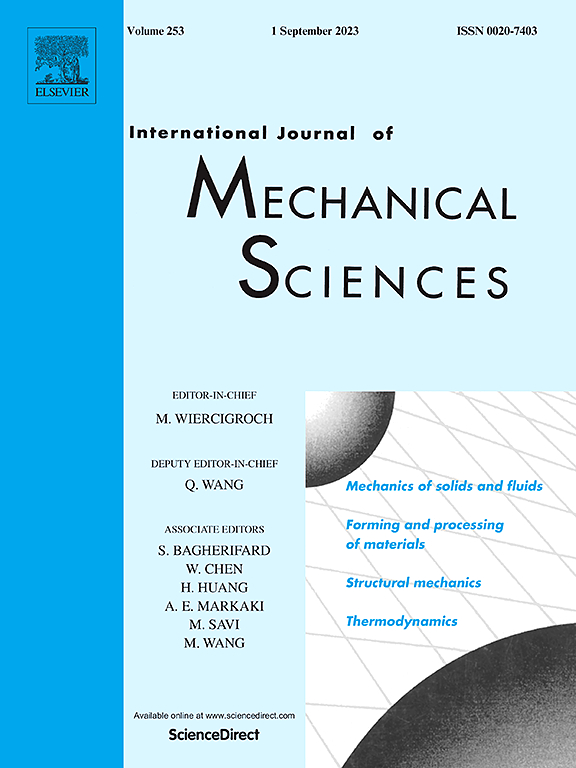Surface quality in ultrasonic-electrolytic internal grinding of GCr15 steel
IF 7.1
1区 工程技术
Q1 ENGINEERING, MECHANICAL
International Journal of Mechanical Sciences
Pub Date : 2025-03-24
DOI:10.1016/j.ijmecsci.2025.110188
引用次数: 0
Abstract
To tackle the issues of poor surface quality, grinding burn, microcrack and deformation in conventional grinding, in this paper, combined the merits of ultrasonic vibration and electrolytic grinding, the material removal characteristics of GCr15 steel in longitudinal torsional ultrasonic electrolytic internal grinding were revealed based on the kinematic analysis of single abrasive particle. Additionally, a theoretical analysis of the heights of material removed by electrolytic action and mechanical grinding was conducted. The single factor experiments were completed for conventional grinding (CG), longitudinal torsional ultrasonic grinding (LTUG), electrolytic grinding (EG) and longitudinal torsional ultrasonic electrolytic grinding (LTUEG). The results demonstrated the superiority of LTUEG processing through comparisons with CG, LTUG and EG. LTUEG shows significant advantages in reducing grinding force, improving surface roughness and quality, and achieving ideal microhardness and residual stress. The formation and removal mechanism of the passivation film were elucidated. The passivation film was primarily composed of iron oxides, hydroxides, and precipitates of the C element. Increasing the voltage helped to increase the thickness of the passive film and reduce the actual grinding depth; however, excessively high voltages could easily lead to residual passive film coverage and electrolytic burn phenomena. The influence of different processing parameters on surface quality was investigated. Within a certain range, increasing the ultrasonic amplitude, voltage, and grinding wheel speed, while decreasing the feed speed, had a beneficial effect on enhancing the surface quality. Therefore, LTUEG is an effective processing method to improve the quality of GCr15 steel.

超声电解内磨GCr15钢的表面质量
针对常规磨削中存在的表面质量差、磨削烧伤、微裂纹和变形等问题,结合超声振动和电解磨削的优点,基于单粒磨料的运动学分析,揭示了GCr15钢纵向扭转超声电解内磨削的材料去除特性。此外,还对电解作用和机械磨削去除的物料高度进行了理论分析。完成了常规磨削(CG)、纵向扭转超声磨削(LTUG)、电解磨削(EG)和纵向扭转超声电解磨削(LTUEG)的单因素试验。通过与CG、LTUG和EG的比较,证明了LTUEG处理的优越性。LTUEG在减小磨削力、提高表面粗糙度和质量、获得理想的显微硬度和残余应力方面具有显著的优势。阐明了钝化膜的形成和去除机理。钝化膜主要由氧化铁、氢氧化物和C元素的沉淀组成。增加电压有利于增加被动膜厚度,减小实际磨削深度;然而,过高的电压容易导致残余的钝化膜覆盖和电解燃烧现象。研究了不同工艺参数对表面质量的影响。在一定范围内,提高超声振幅、电压和砂轮转速,同时降低进给速度,有利于提高表面质量。因此,LTUEG是提高GCr15钢质量的有效加工方法。
本文章由计算机程序翻译,如有差异,请以英文原文为准。
求助全文
约1分钟内获得全文
求助全文
来源期刊

International Journal of Mechanical Sciences
工程技术-工程:机械
CiteScore
12.80
自引率
17.80%
发文量
769
审稿时长
19 days
期刊介绍:
The International Journal of Mechanical Sciences (IJMS) serves as a global platform for the publication and dissemination of original research that contributes to a deeper scientific understanding of the fundamental disciplines within mechanical, civil, and material engineering.
The primary focus of IJMS is to showcase innovative and ground-breaking work that utilizes analytical and computational modeling techniques, such as Finite Element Method (FEM), Boundary Element Method (BEM), and mesh-free methods, among others. These modeling methods are applied to diverse fields including rigid-body mechanics (e.g., dynamics, vibration, stability), structural mechanics, metal forming, advanced materials (e.g., metals, composites, cellular, smart) behavior and applications, impact mechanics, strain localization, and other nonlinear effects (e.g., large deflections, plasticity, fracture).
Additionally, IJMS covers the realms of fluid mechanics (both external and internal flows), tribology, thermodynamics, and materials processing. These subjects collectively form the core of the journal's content.
In summary, IJMS provides a prestigious platform for researchers to present their original contributions, shedding light on analytical and computational modeling methods in various areas of mechanical engineering, as well as exploring the behavior and application of advanced materials, fluid mechanics, thermodynamics, and materials processing.
 求助内容:
求助内容: 应助结果提醒方式:
应助结果提醒方式:


